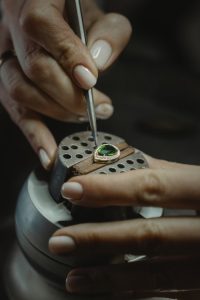
Emeralds, the birthstone of May, have been prized as precious jewels for thousands of years.
The history of emerald mining stretches back over 5000 years to when the Egyptian Pharaohs wore stones sourced from what are now referred to as Cleopatra’s Mines. By 1000BC these mines were producing emeralds for Middle Eastern and European Kings and Queens. Sporadic production continued through the Roman era and right up until the 13th Century when Turks and Arabs worked these deposits.
On the other side of the world in Pre-Columbian times emeralds were being mined by the Incas in a place where the world’s best emeralds are still found today. The Spanish conquests of South America saw these deposits mined to produce enormous quantities of rough material, with a great proportion ending up in the hands of the nobility of India. More recent times saw the discovery of good quality emeralds in Russia in 1830, India in the 1940s, Pakistan and Brazil in the 1960s and Afghanistan in the 1970s. During the last century the African continent has also proved to be a major source of emeralds with production from Zambia, Zimbabwe and Madagascar.
Australia also has its emeralds. The first discovery was in Northern NSW in the late 1800s when emeralds were recovered by hand mining a 100 metre deep vertical shaft. Although the emeralds were small in size they did have an attractive light emerald-green colour.
Emeralds were then discovered in Western Australia in 1912 at Poona, 500 km north-east of Perth. The main mine of the district was the Aga Khan which operated on and off for more than 70 years until 1980 and yielded an estimated 10,000 grams of mostly low value emerald. During the1980s another mine in WA was worked some 40kms west of Menzies.
Then during the early 1990s a small but very interesting deposit of emeralds was discovered under an unsealed road near Torrington in Northern NSW. Quite a bit of material came onto the market at the time but as there has been no production recorded for some time, rough and cut pieces are now collector items. The single well formed crystals show a unique colour banding sometimes referred to as ‘Bar Code Banding’ making them extremely attractive specimens. Some fine quality cut stones have been produced from the thicker colour bands and have been known to change hands for around $AUD 1000 per carat.
The only truly Australian emerald that has gained world wide recognition and international demand is the Biron Synthetic Emerald. Produced in Perth for the last 10 years, the Biron emerald is what many people in the industry still consider the world’s best quality synthetic emerald.
Today most emeralds are sourced from Columbia, Brazil, Zambia, Zimbabwe, Pakistan and Russia.
Most of the emeralds have so many inclusions and fractures that the effect is described as jardin, the French word for garden. In order to disguise these fractures, emeralds are often “oiled” with a colourless oil or resin so that surface-reaching cracks are far less visible.
Good quality emeralds without any inclusions are extremely rare and therefore often cost more than diamonds.
For more information contact the Gemmological Association of Australia at www.gem.org.au